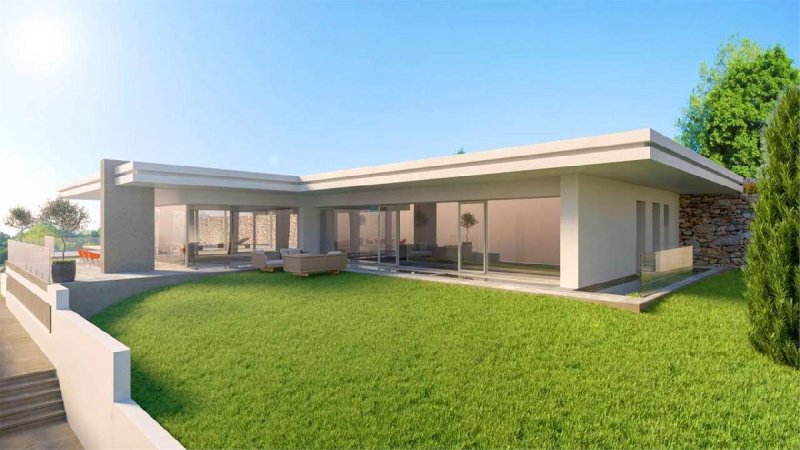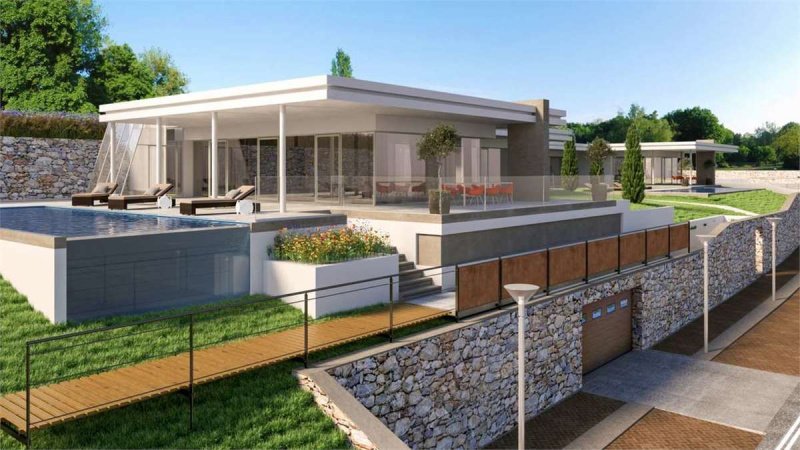Padenghe sul Garda, discreet and convenient location for services, super-luxury villa of the highest level and large size, finished with precious details and maximum technology, equipped with integrated solar panels.
Extraordinary panoramic lake view from all points of the property thanks to the large windows, south-east exposure, very bright and airy, equipped with a lift connected to the garage and infinity pool.
The villa is divided over 3 floors:
Basement of 305 sq m walkable with quadruple garage, paestra, wellness area and, if desired, a bedroom;
Ground floor of 332 square meters with living room, kitchen, bedrooms and bathrooms;
Solarium of 350 square meters with a fantastic view over the lake.
Strategic position for communications just a few minutes from the motorway, the ring road, the railway station and, consequently, also convenient to the airports of Verona and Montichiari.
Lake Garda
Lake Garda or Benaco is the largest Italian lake, with an area of about 370 km² (third by depth after Como and Maggiore). A hinge between three regions, Lombardy (province of Brescia), Veneto (province of Verona), Trentino-Alto Adige (province of Trento), it is parallel to the Adige, from which it is divided by the Monte Baldo massif. To the north it is narrow and funnel-shaped while to the south it widens, surrounded by moraine hills that make the landscape sweeter. The lake is an important tourist destination and is visited by millions of people every year. In Roman times the lake was known as Benacus and by some it was revered as god Benacus, the very personification of the lake, sometimes associated with the cult of the god Neptune. Today it is better known as Lake Garda, a toponym attested since the Middle Ages and of Germanic origin, deriving from that of the homonymous town on the Veronese shore of the lake, which, together with another famous locality of the lake, Gardone Riviera, and others less known, such as Gàrdola, Gardoncino, Gardoni, Guàrdola and Le Garde, testifies to the Germanic presence that goes from the sixth to the eighth century, in particular the Lombard one. The toponym Garda, with which the lake is already called in some documents of the eighth century, is the evolution of the Germanic word warda, or "guard place" or "place of observation". The classic toponym of the lake, or Bencus lacus (Benaco), is almost certainly of Celtic origin, thus preceding the Roman dominion, and should derive from bennacus, comparable with the Irish bennach, and would mean "horned", or from the many promontories. The translation "horned" is also interpreted in reference to the Sirmione peninsula. The Latin voice of Benaco is attested as Bencus, -i and therefore presupposes a flat accent (Benàco): the Italian version of the tonic accent remains faithful to the Latin accent, so it must be pronounced with the accent on "a". The inhabitants of the lake, especially those of the Veronese shore, pronounce the name Benaco with the accent on the "e", or Bènaco. It remains unclear why natives of the lake areas tend to use the slippery accent version of the name.
自动翻译所用的语言
Padenghe sul Garda, in posizione discreta e comoda ai servizi, villa superlusso di altissimo livello e ampia metratura, rifinita con accorgimenti preziosi e massima tecnologia, equipaggiata con pannelli solari integrati.
Straordinaria vista lago panoramica da tutti i punti della proprietà grazie alle grandi vetrate, esposizione a sud-est, molto luminosa e ariosa, dotata di ascensore collegato al box e pisicna infinity.
La villa si divide su 3 piani :
Piano interrato di 305 mq calpestabili con box auto quadruplo, paestra, zona wellness e, se desiderato, una camera;
Piano terra di 332 mq calpestabili con sala, cucina, camere e bagni;
Solarium di 350 mq calpestabili con una vista fantastica su tutto il lago.
Posizione strategica alle comunicazioni a pochi minuti dall'autostrada, dalla tangenziale, stazione ferroviaria e, di conseguenza, comoda anche agli aeroporti di Verona e Montichiari.
Il lago di Garda
Il lago di Garda o Benaco è il maggiore lago italiano, con una superficie di circa 370 km² (terzo per profondità dopo Como e Maggiore). Cerniera fra tre regioni, Lombardia (provincia di Brescia), Veneto (provincia di Verona), Trentino-Alto Adige (provincia di Trento), è posto in parallelo all'Adige, da cui è diviso dal massiccio del monte Baldo. A settentrione si presenta stretto a imbuto mentre a meridione si allarga, circondato da colline moreniche che rendono più dolce il paesaggio. Il lago è un'importante meta turistica ed è visitato ogni anno da milioni di persone. In epoca romana il lago era conosciuto come Benacus e da alcuni era venerato come dio Benacus, personificazione stessa del lago, talvolta associata al culto del dio Nettuno. Oggi è meglio noto come lago di Garda, toponimo attestato fin dal Medioevo e di origine germanica, derivante da quello dell'omonima cittadina sulla sponda veronese del lago, la quale, insieme a un'altra località celebre del lago, Gardone Riviera, e altre meno conosciute, come Gàrdola, Gardoncino, Gardoni, Guàrdola e Le Garde, testimonia la presenza germanica che va dal VI all'VIII secolo, in particolare quella longobarda. Il toponimo Garda, con il quale è chiamato il lago già in alcuni documenti dell'VIII secolo, è l'evoluzione della voce germanica warda, ovvero "luogo di guardia" o "luogo di osservazione". Il toponimo classico del lago, ovvero Bencus lacus (Benaco), è quasi sicuramente di origine celtica, precedente quindi al dominio romano, e dovrebbe derivare da bennacus, confrontabile con l'irlandese bennach, e significherebbe "cornuto", ovvero dai molti promontori. La traduzione "cornuto" viene anche interpretata in riferimento alla penisola di Sirmione. La voce latina di Benaco è attestata come Bencus, -i e presuppone quindi un accento piano (Benàco): la versione italiana dell'accento tonico rimane fedele all'accentazione latina, quindi va pronunciato con l'accento sulla "a". Gli abitanti del lago, in particolar modo quelli della sponda veronese, pronunciano il nome Benaco con l'accento sulla "e", ovvero Bènaco. Resta oscuro il motivo per cui i nativi delle zone del lago tendono ad utilizzare la versione con l'accento sdrucciolo del nome.
CLASSE ENERGETICA: A+
Padenghe sul Garda, diskrete und günstige Lage für Dienstleistungen, Super-Luxus-Villa auf höchstem Niveau und groß, mit wertvollen Details und maximaler Technologie ausgestattet, ausgestattet mit integrierten Sonnenkollektoren.
Außergewöhnlicher Panoramablick auf den See von allen Punkten des Grundstücks dank der großen Fenster, Südostausrichtung, sehr hell und luftig, ausgestattet mit einem Aufzug, der mit der Garage und dem Infinity-Pool verbunden ist.
Die Villa ist auf 3 Etagen verteilt:
Keller von 305 qm begehbar mit vierfacher Garage, Paestra, Wellnessbereich und, falls gewünscht, einem Schlafzimmer;
Erdgeschoss von 332 Quadratmetern mit Wohnzimmer, Küche, Schlafzimmer und Badezimmer;
350 Quadratmeter großes Solarium mit fantastischem Blick über den See.
Strategische Lage für die Kommunikation nur wenige Minuten von der Autobahn, der Ringstraße, dem Bahnhof entfernt und damit auch günstig zu den Flughäfen von Verona und Montichiari.
Gardasee
Der Gardasee oder Benaco ist mit einer Fläche von ca. 370 km² der größte italienische See (dritter nach Como und Maggiore). Es ist ein Scharnier zwischen drei Regionen, der Lombardei (Provinz Brescia), Venetien (Provinz Verona) und Trentino-Südtirol (Provinz Trient). Es verläuft parallel zur Etsch, von der es durch das Monte Baldo-Massiv getrennt ist. Im Norden ist es schmal und trichterförmig, während es sich im Süden erweitert, umgeben von Moränenhügeln, die die Landschaft süßer machen. Der See ist ein wichtiges Touristenziel und wird jedes Jahr von Millionen von Menschen besucht. In der Römerzeit war der See als Benacus bekannt und wurde von einigen als Gott Benacus verehrt, die Personifikation des Sees, die manchmal mit dem Kult des Gottes Neptun in Verbindung gebracht wird. Heute ist es besser bekannt als der Gardasee, ein seit dem Mittelalter bezeugtes Toponym germanischen Ursprungs, das sich von der gleichnamigen Stadt am veronesischen Ufer des Sees ableitet, die zusammen mit einem anderen berühmten Ort des Sees, der Gardone Riviera, und andere weniger bekannte wie Gàrdola, Gardoncino, Gardoni, Guàrdola und Le Garde zeugen von der germanischen Präsenz vom 6. bis zum 8. Jahrhundert, insbesondere der lombardischen. Das Toponym Garda, mit dem der See bereits in einigen Dokumenten des 8. Jahrhunderts genannt wird, ist die Entwicklung des germanischen Wortes warda oder "Wachort" oder "Beobachtungsort". Das klassische Toponym des Sees oder Bencus lacus (Benaco) ist mit ziemlicher Sicherheit keltischen Ursprungs und geht somit der römischen Herrschaft voraus. Es sollte von Bennacus abgeleitet sein, vergleichbar mit dem irischen Bennach, und würde "gehörnt" oder von vielen bedeuten Vorgebirge. Die Übersetzung "gehörnt" wird auch in Bezug auf die Halbinsel Sirmione interpretiert. Die lateinische Stimme von Benaco wird als Bencus -i attestiert und setzt daher einen flachen Akzent (Benàco) voraus: Die italienische Version des tonischen Akzents bleibt dem lateinischen Akzent treu, daher muss er mit dem Akzent auf "a" ausgesprochen werden. Die Bewohner des Sees, insbesondere die des veronesischen Ufers, sprechen den Namen Benaco mit dem Akzent auf dem "e" oder Bènaco aus. Es bleibt unklar, warum Eingeborene der Seegebiete dazu neigen, die Version des Namens mit rutschigem Akzent zu verwenden.


